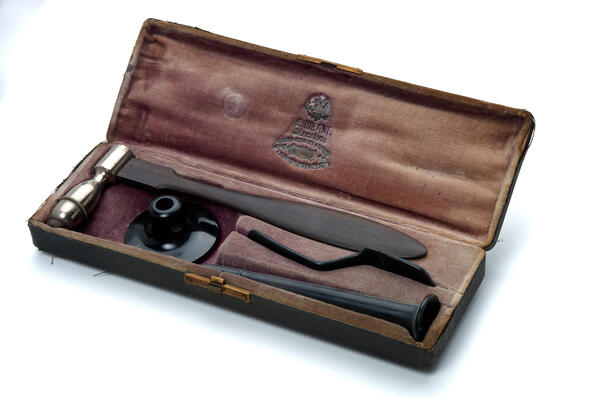There is a doctor’s kit at the ‘Old Tula Pharmacy’ exhibition, which was made at the factory of Theodore (Fedor) Schwabe in the middle of the 19th century. Medical instruments could then be ordered to the pharmacy manager, who went to Moscow to buy goods almost every week.
Fedor Schwabe opened his company that manufactured and sold optical devices on Myasnitskaya street in Moscow in 1837. Soon it became a place where one could buy the most advanced inventions of the 19th century. The store’s list of products included lenses, folding tripods, daguerreotype plates, photographic paper. An astronomical observatory was built on the roof of the trading house. By the end of the 19th century, the company of Fedor Schwabe became one of the largest manufacturers of optical, physical, and medical instruments in the country.
The 19th century doctor’s kit included a percussion hammer, a plessimeter, and a collapsible stethoscope. These tools were used by doctors of different specialties, and a similar kit was also available to a general practitioner who was obliged to possess knowledge in any field of medicine.
The word ‘plessimeter " is derived from the Greek plessein, which means ‘to hammer at’, and metron — ‘measure’. This medical instrument is a curved plate made of ebony, ivory, or metal. During the examination, a plessimeter was placed in contact with the patient’s body to study the state of internal organs by tapping. This method is called percussion.
Percussion as an independent method was invented by the Austrian doctor Leopold Auenbrugger in the second half of the 18th century. Auenbrugger used percussion placing his fingers in a pyramid shape. The method of percussion with instruments has been used since 1846, when the German doctor Anton Wintrich proposed using a percussion hammer for diagnosis. However, this method was not recognized, and the doctors soon returned to finger percussion. Here the fingers of the left hand served as a plessimeter, and the middle fingers of the right hand served as a hammer. Depending on the purpose of the study, the doctors used different phalanges of the fingers.
A stethoscope is a tube with a removable bell, which was used to listen to noises coming from the heart, blood vessels, lungs, and other internal organs. It was an indispensable diagnostic tool of a doctor of the 19th century, but it was replaced by the phonendoscope — the invention of the Russian doctor Nikolai Korotkov — at the beginning of the 20th century.



